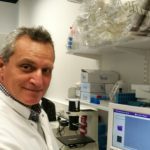Lien vers Pubmed [PMID] – 19240691
Mol. Ther. 2009 Jun;17(6):992-1002
Brachial plexus injury is frequent after traffic accident in adults or shoulder dystocia in newborns. Whereas surgery can restore arm movements, therapeutic options are missing for sensory defects. Dorsal root (DR) ganglion neurons convey sensory information to the central nervous system (CNS) through a peripheral and a central axon. Central axons severed through DR section or avulsion during brachial plexus injury inefficiently regenerate and do not reenter the spinal cord. We show that a combination of microsurgery and gene therapy circumvented the functional barrier to axonal regrowth at the peripheral and CNS interface. After cervical DR section in rats, microsurgery restored anatomical continuity through a nerve graft that laterally connected the injured DR to an intact DR. Gene transfer to cells in the nerve graft induced the local release of neurotrophin-3 (NT-3) and glial cell line-derived neurotrophic factor (GDNF) and stimulated axonal regrowth. Central DR ganglion axons efficiently regenerated and invaded appropriate areas of the spinal cord dorsal horn, leading to partial recovery of nociception and proprioception. Microsurgery created conditions for functional restoration of DR ganglion central axons, which were improved in combination with gene therapy. This combination treatment provides means to reduce disability due to somatosensory defects after brachial plexus injury.

